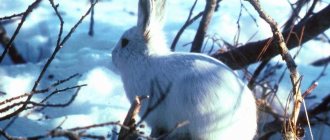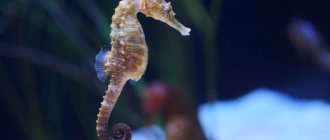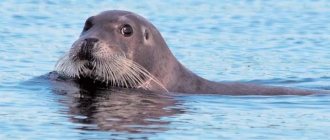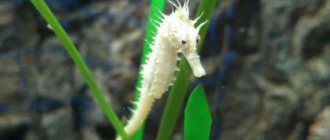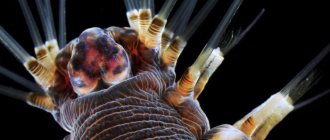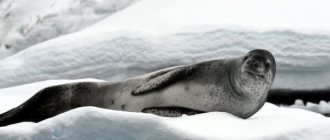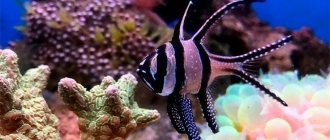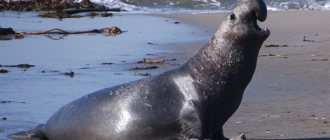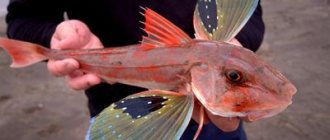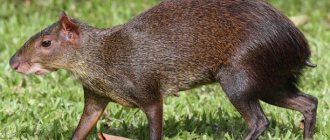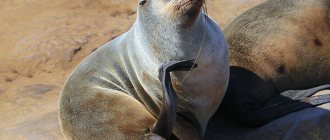- Wild animals
- >>
- Mammals
The sea hare is a large pinniped mammal belonging to the family of true seals. Sea hares are very hardy animals because they live in the harsh conditions of the Far North; they can be found on the shores of the North, Atlantic and Pacific oceans. These animals got their name for their timidity and unusual manner of moving on land. Erignathus barbatus sea hare is a fairly common species, despite the fact that these animals are constantly hunted, since the meat, fat and skin of the animal are of great value, the species does not need special protection.
Origin of the species and description
Photo: Sea hare
The sea hare, or as this animal is popularly called bearded seal, is a pinniped animal belonging to the class of mammals, the order of predators, and the family of true seals. Genus Erignathus sea hare species. This species was first described by the German scientist Johann Christian Polycarp in 1777. Previously, scientists considered pinnipeds as an independent order of Pinnipedia.
Video: Sea hare
Modern pinnipeds descended from animals of the order Desmostylia that lived during the desmostylia period from the early Oligocene to the late Miocene. The family of true seals includes 19 species and 13 genera. Recently, in 2009, scientists created a description of the seal ancestor Puijila darwini, whose fossil age is 24-20 million years. Fossils were found on the shores of Greenland. Sea hares are very large animals. The body length of the sealed seal is about 2-2.5 meters. The weight of an adult in winter can reach 360 kg.
Sea hares have a large, massive body. The head is small and round in shape. The animal has powerful jaws in order to tear apart prey, but the animal’s teeth are small and quickly deteriorate. Sea hares are blue-gray in color. The sea hare got its name from its unusual for seals way of moving on land by jumping. Despite their rather large size, the animals are very shy and try to hide from prying eyes.
Appearance and features
Photo: What a sea hare looks like
The bearded seal is a very large animal with a large elongated body, a small round head and flippers instead of legs. The size of an adult individual is about 2-2.5 meters in length. The weight of an adult male is up to 360 kg. Body weight varies greatly depending on the season and quality of life. The axillary girth is approximately 150-160 cm. Males are much larger than females. Outwardly, the animals look very clumsy, although in the water they can move quite quickly and swim very gracefully.
The animal's head is round and its eyes are small. The irises of the eyes are dark in color. The animal's jaws are very strong and powerful, but the teeth are small and quickly deteriorate. Adults and old individuals have practically no teeth, because they deteriorate early and fall out. The muzzle also has rather long and thin whiskers, which are responsible for the sense of touch. The sea hare has practically no ears; this species has only internal auricles.
Sea hares have sparse hair. The color of the adult is gray-white. The fur on the back is darker. On the front of the muzzle and around the eyes the color of the coat is yellowish. The young of this species have a brownish-brown color, which makes them different from other representatives of this family. Other representatives of seals are born with a fluffy pure white coat. There are no differences in color between males and females. Old individuals are almost white in color. The front flippers are located almost at the neck, while the neck itself is practically absent. The small head immediately goes into the body. Sea hares make quite loud sounds similar to a bear's roar, especially in case of danger. During mating games, males whistle underwater.
Interesting fact: In spring, males sing songs underwater with their loud voices. For a person, this song is like a long, drawn-out whistle. The sounds can be melodic and high, or they can be dull. The male attracts females with his songs, and females who have stopped feeding their cubs with their milk respond to this call.
The lifespan of males is about 25 years, females live much longer up to 30-32 years. The main cause of death is helminth infection and tooth decay.
Opalin completely deprives predators of their sense of smell
The researchers decided to test their hypothesis. They took opaline from the glands of the sea hare (it should be noted that it is produced separately from the coloring pigments) and applied it to the lobster's antennae, which in this arthropod play the role of an olfactory organ. After that, an extract from shrimp was added to the aquarium with this lobster, which the predator feeds on in the wild and, therefore, knows their smell by heart.
As a result, it turned out that the lobster did not react at all to the delicious smell that was quite familiar to it. Most likely because I just didn't feel it. As scientists write in an article published in the Journal of Experimental Biology, according to their research, those neurons responsible for chemoreception, as well as the motor nerve cells associated with them, remained completely inactive all this time. And this is very strange - usually they are immediately excited by the smell of food and excite the hunting reflexes of the crayfish.
It turns out that opaline is indeed capable of completely suppressing the sense of smell. Professor Charles Derby, who led the study, said:
this substance, isolated from the glands of the sea hare, literally clogs the “nose” of the predator. And opaline does this in the following way - it sticks to the receptors on the lobster’s antennae and simply physically prevents odor molecules from reaching them.
It is quite obvious that as a result of such an opaline attack, the predator completely loses its sense of smell for some time. And, what is most interesting, the appetite disappears along with it - after all, if there is no smell, then hunting behavior is not aroused. Well, while he is cleaning the antennas from the scorch sticking to them, even such a slow-moving and bumpkin as the sea hare always manages to climb into some crevice between the stones and hide.
Where does the sea hare live?
Photo: Sea hare seal
Sea hares live on the shores of the Arctic Ocean and in the Arctic seas, mainly in shallow depths. Sea hares can be found on the shores of the Kara, White, Barents and Laptev Seas, in the waters of Spitsbergen on the New Siberian Islands. It is also found in the west of the East Siberian Sea. There are several populations of sea hares isolated from each other. Thus, there is a Pacific population and an Atlantic one.
The Pacific subspecies lives in the eastern half of the East Siberian Sea. The habitat of this species extends to Cape Barrow. Lahtaki live on the coasts of the Barents Sea and the Adygei Gulf. The Atlantic subspecies lives on the shores of northern Norway, off the coast of Greenland and in the Canadian Arctic Archipelago. Sometimes there are small settlements of sea hares near the North Pole.
By their nature, sea hares are sedentary animals and do not make seasonal migrations of their own free will, however, they are often carried over long distances by drifting ice floes. Sea hares can sometimes travel long distances in search of food. In the warm season, these animals gather in rookeries near low coasts. Rookeries can number up to hundreds of individuals. In winter, bearded seals move to the ice and live there in small groups of several individuals. And also, some individuals remain on land in winter and can dig holes in the snow with a loophole exit to the sea.
Now you know where the bearded seal, or bearded seal, lives. Let's see what they eat.
Research on the White Sea: 1980s
V. Yushmanov ( left
) and A. Agafonov record acoustic signals of sea hares. Konyukhova Bay. 1985
In the early 80s of the twentieth century. The work carried out by the laboratory of marine bioacoustics of the Institute of Oceanology (IO) named after P. P. Shirshov of the USSR Academy of Sciences under the leadership of Doctor of Biological Sciences V. M. Belkovich (1935–2016) gained momentum. In particular, comprehensive studies of White Sea beluga whales have been carried out for several years; it was possible to collect a lot of interesting data on their behavior and acoustic signaling, as well as on the distribution of beluga whale communities in various areas of the White Sea in the summer-autumn period. However, almost nothing was known about what happens to animals in winter, when the White Sea is partially covered with ice.
At the end of February 1984, a small scientific group went to the area of the village of Letnyaya Zolotitsa - where summer field work was carried out annually. Scientists set out to conduct visual observations and “listen” to the water area from fast ice, and, if possible, at the edge of open water. The main object of research was considered to be the beluga whale, although Belkovich, admonishing his colleagues, uttered mysterious words: “Or maybe you’ll hear someone else.”
V. Yushmanov is drilling a hole for immersing a hydrophone. Konyukhova Bay, 1985
To carry out observations, on the advice of local residents, they chose Konyukhova Bay - a semicircular bay six kilometers across, located 12 km from the village. During the winter, solid ice about a meter thick, covered with dense snow, formed on the sea. Although March had already arrived, the weather was quite wintry: at night it dropped to −25°C, during the day it was usually −10–12°C; even by the end of the expedition, i.e. in mid-April, the temperature was below zero. There were several hunting huts on the shore, in one of which the scientists settled. In the evening, a kerosene lamp was lit, and a stove was used for heating and cooking. There were no problems with firewood - there was taiga all around, but water had to be melted from the snow, since it was not possible to find springs in winter. Contact with the outside world was maintained through letters: once every two or three days, a postman rode past the hut on his way from Letnyaya Zolotitsa to the village of Pushlakhta on a horse-drawn sleigh. If there was a need for operational communication, we got to Letnyaya Zolotitsa on foot along a sled track in about three hours. And sometimes AN-2 flew there from Arkhangelsk, and, most importantly, there was a post office there, from where you could send a telegram, and if you were very lucky, even order a telephone conversation with Moscow. The last century, in a word...
Having settled in, we began collecting scientific material, for which we went out onto the ice on skis, drilled holes in the designated places and lowered the hydrophone into the water. It should be noted that the sea ice is loose, a meter-thick layer was drilled by hand in just a few minutes, so that during the working day it was possible to survey a fairly large area. And the very first experiments showed that under water constantly (as it later turned out, even at night) some very melodic sounds, reminiscent of whistles and howls, are heard. They were completely different from the beluga whale signals that had been well described by that time. At first, scientists even suggested that it was the air whistling as it seeped through cracks in the ice. However, even by ear, a relatively small number of signal types were easily identified, which were continuously repeated in different combinations. Some of them lasted up to a minute. In general, only living creatures could make such sounds. But which ones?
A message about the first results was sent by telegraph to Moscow, which aroused such interest in Belkovich that he immediately went to the White Sea, reached Konyukhovaya Bay and personally took part in the work. And I soon came to the conclusion that the data we obtained were consistent with previously published results of studies of foreign bioacoustics, and, most likely, we recorded the signals of sea hares.
Upon returning to Moscow, I managed to get a copy of the issue of Zoologica
(all the way back to 1969!), in which we read an article by K. Ray and colleagues [], devoted to research into the underwater acoustic signaling of bearded seals in the Bering Sea. The authors proved that sexually mature males produce signals, and specifically during the reproductive period of life. The article was well illustrated with spectrograms, and even included a flexible gramophone record with the original sound recordings. Thus, the identity of the White Sea signals was now beyond doubt.
Our laboratory conducted two more expeditions to Konyukhovaya Bay - in 1985 and 1987; During each season of field work, approximately 15 hours of acoustic recordings were obtained there. In addition, about four hours were recorded in the spring of 1995 in the Solovetsky archipelago area. The recordings were made, naturally, using a cassette recorder. The collected acoustic material was subjected to a complete classroom analysis and selective processing on a spectrum analyzer, and the signals were classified as far as the technology allowed (Fig. 1) [, ]. Unfortunately, more detailed processing and study of the recordings turned out to be impossible with the equipment available at that time.
Rice. 1.
Spectrograms of signals taken in the 1980s (from: [])
What does a sea hare eat?
Photo: Lakhtak, or sea hare
Sea hares are typical biological species. They feed on animals that live on the bottom of the sea and in the bottom part at a depth of about 55-60 meters. Although these animals can dive to a depth of 145 meters. During a hunt, it can stay at a depth of 100 meters for up to 20 minutes, but on a voyage it often settles at shallow depths of up to 60-70 meters. At such a depth, animals feel more comfortable, so these animals are practically not found in very deep seas. They can get to such places on drifting ice floes.
The diet of seal hares includes:
- gastropods;
- cephalopods;
- islanian scallop;
- Macoma calcarea;
- polychaetes;
- fish (smelt, herring, cod, sometimes drumstick, sand lance and omul);
- crabs;
- shrimps;
- echiuridae;
- crustaceans, such as snow crab, and others.
Interesting fact: During a hunt, a sea hare can stay underwater for up to 20 minutes at great depths.
Sea hares catch fish in the water. Predators lift crabs, shrimp and mollusks from the bottom; the animals are helped by their wide flippers with long claws. Sea hares are good at digging up sea soil in order to feast on the crustaceans and mollusks that hide in it. Thanks to their strong jaws, sea hares can easily chew through the hard shells of crustaceans. If there is not enough food in the area of their usual habitat, animals can migrate long distances in search of food.
Features of character and lifestyle
Photo: Black sea hare
Sea hares are very calm and even lazy animals. They are slow, but they are in no particular hurry. Even while hunting, these animals have nowhere to rush, because their prey will not escape from them. On land they are very clumsy due to their body structure, but in water they are quite graceful. Sea hares like to spend time alone, they are not sociable, but they are not at all aggressive. The flock is very friendly and there are never any clashes between relatives, even during the breeding season.
Sea hares do not divide territory and do not compete for females. The only thing these animals don’t like is crowded conditions, so in rookeries they try to be located as far as possible from their neighbors. These animals are very shy, and they have something to be afraid of because they are hunted by many predators, so if they have the opportunity to lie down while lying closer to the water, the animals do just that in order to notice the danger, quickly dive under the water and hide from persecution. In autumn, these animals move to the ice floes in small families or alone. On ice floes, seals migrate passively over long distances.
Sea hares have a very developed parental instinct. The mother takes care of the offspring for a long time, and later the young seals follow their mother for a long time. But seals do not build families; pairs are formed exclusively for reproduction for a few days; after mating, the pair breaks up.
How to cook in the oven
Before you start preparing the European chimera, you need to consider:
- The eyes should be transparent, and the gill slits inside should be reddish. This is evidence of titushka's freshness.
- When cutting, do not damage the fins. If this is allowed, the meat will taste bitter.
- The meat is quite tough, but juicy. Therefore, you need to know exactly how to prepare it correctly.
You can use the following original fish recipe.
Source
Social structure and reproduction
Photo: Sea hare calf
Young females are ready to mate at the age of 4-6 years, males mature a little later and are ready to breed at the age of 5-7 years. The mating season for these animals begins in April. The beginning of the mating season can be identified by the very peculiar underwater songs of the males. Males, ready to procreate, emit loud songs underwater, similar to a whistle, calling for females. Despite their peaceful nature, finding a mate for a sea hare is quite difficult, due to the fact that sea hares are extremely unsociable. Mating occurs on ice.
The female's pregnancy lasts about 11 months. In this case, the first few months there is a delay in implantation and development of the fertilized egg. This is normal for all pinnipeds. Without the latent phase, pregnancy lasts 9 months. During puppies, females do not form clusters, but whelp and care for the offspring alone.
After almost a year of pregnancy, the female gives birth to only one cub. The body size of the cub at birth is 120-130 cm. Weight is from 25 to 35 kg. The first moult occurs in the baby in the womb. Beard seals are born with a grayish-brown color. Two weeks after birth, the cub is able to swim. The mother feeds the cub with milk for the first month, later the cubs switch to regular food. A few weeks after the end of feeding, the female is ready for the next mating.
Interesting fact: The milk that is released during feeding is very fatty and nutritious. The fat content of milk is approximately 60%; a baby can drink up to 8 liters of mother's milk in one day.
21st century: new technology, new opportunities, new challenges
At the beginning of this millennium, computers opened up enormous possibilities for science. In particular, bioacoustics have received a powerful tool for visualizing and analyzing sound signals. Adobe Audition the most
- a music editor intended by the developers for composers, music arrangers, performers, etc. But this program has an excellent window that allows you to present spectrograms and oscillograms of sounds online. Moreover, it is possible to measure the duration of signals with an accuracy of milliseconds, and their frequency characteristics - up to several hertz. Subsequently, special programs were also developed for working with animal and human sound signals. As a result, audio recordings made in the 1980s and even earlier have been given a second life.
In 2004, all the material preserved on audio cassettes was digitized using the Adobe Audition 1.5
, which subsequently made it possible to conduct a detailed analysis and typology of the recorded signals, while we were able to identify seven main types (Fig. 2).
Rice.
2. Spectrograms of the seven main types of signals identified in the 2000s (explanations are given in the text of the article)
Type 1.
A continuous signal consisting of two phases: nonlinear and linear decrease in the frequency of the fundamental tone. The fundamental frequency itself experiences periodic fluctuations in the range of 300–500 Hz, which become more rare towards the end of the signal. Frequency range from 5 (start point) to 0.5 kHz (end point). Within the type, two fairly stable variants (subtypes) can be distinguished, differing in duration: short (5–15 s) and long (15–30 s).
Type 2.
A signal with a lower frequency of the fundamental tone that experiences periodic oscillations. Resembles the final phase of a Type 1 signal. Signal duration is 10–20 s, frequency range is from 2.5 (start point) to 0.5 kHz (end point).
Type 3.
A signal consisting of two phases: an increase in the frequency of the fundamental tone to a peak point and a subsequent decrease. There are no fluctuations in the fundamental tone frequency. Signal duration from 3 to 6 s, frequency range from 1.5 (peak point) to 0.2 kHz (start and end points).
Type 4.
A signal with a smooth nonlinear decrease in the frequency of the fundamental tone. Its fluctuations are insignificant or absent. Harmonics are often noted at the beginning of the signal. Signal duration from 4 to 8 s, frequency range from 3 (starting point) to 0.2 kHz (end point).
Type 5.
A signal with a sharp nonlinear decrease in the frequency of the fundamental tone. There is no hesitation. At the end of the signal there is sometimes a slight increase in frequency. Usually follow in series of 3–5 signals. Signal duration from 1 to 3 s, frequency range from 2.5 (starting point) to 0.2 kHz (end point).
Type 6.
A low-frequency signal similar to a howl or groan. There is very little or no reduction in frequency. Signal duration is from 3 to 6 s, frequency range is approximately 0.4–0.2 kHz.
Type 7.
The most complex in structure of all the identified types. Consists of several segments. First, there follows a phase of nonlinear decrease in the frequency of the fundamental tone with periodic oscillations. As the frequency decreases, the amplitude of the oscillations and the distance between their peaks begin to increase; the signal takes on a sawtooth shape. Then the formation of “trills” occurs - areas with a decreasing and oscillating frequency of the fundamental tone, interconnected by areas of increasing frequency. The general trend is a decrease in the frequency of the fundamental tone. Finally, the continuous signal is divided into individual trills; the frequency of the fundamental tone of each of them decreases, but the beginning of the next trill is always higher than the end of the previous one. Their duration increases, and the amplitude of fluctuations in the frequency of the fundamental tone in the last trills of the series decreases. The end of the very last one usually takes on the character of a howl. The duration of the signal as a whole can exceed 1 minute, the frequency range is from 7 (starting point) to 0.2 kHz (end point of the last trill).
In general, we note that the general typology of signals in the recordings made over several seasons in the late 1980s - mid-1990s is almost identical. All selected types of signals are represented as elements of a single interconnected structure; individual fragments of different types can be very similar to each other.
Rice. 3.
An example of a comparative analysis of the same type of seal hare signals in order to identify their individual frequency characteristics: a fragment of a spectrogram of a signal of type 1 (
top
);
“key points” at which the frequency characteristics of the signals were measured ( below
)
We conducted a comparative analysis of signals of the same type in order to identify their individual frequency characteristics (using the example of signals of type 1). These signals consist of cycles lasting 0.3–0.5 s (Fig. 3), in total there can be up to 25 such cycles. Within each of them, four characteristic “key” points were identified, indicated in the figure by the letters A
,
B
,
C
and
D
.
It turned out that throughout the signal the frequencies corresponding to these points change from cycle to cycle with the same pattern, so to compare different signals it is enough to measure the frequency at one of the points. D
was chosen as the most clearly visible point in the cycle.
Thus, it became possible to depict the signals as sequences of cycle numbers and the corresponding frequency characteristics of the point selected for each of them. Using the described technique, we analyzed 10 signals and constructed a two-dimensional histogram of the distribution of frequency characteristics of
point D. As a result, the processed signals were divided into three groups. The first, “low-frequency”, includes five signals, the second – four. Finally, one signal, high frequency, represents the third group. Based on the results obtained, we can, with a certain degree of caution, assume that these 10 signals were produced by three different individuals.
Rice. 4.
Overlay on a spectrogram of signals of various types produced by five individuals
When analyzing spectrograms, it was often observed that some signals overlapped others in time, which indicates the simultaneous reproduction of sounds by several individuals in the hydrophone reception area (Fig. 4). By comparing the number of animals emitting (producing) signals identified in this way and the data from the analysis of the frequency characteristics of the latter, we are able to fairly accurately determine the number of individuals present in the studied water area.
Natural enemies of sea hares
Photo: What a sea hare looks like
The natural enemies of sea hares are:
- White bears;
- killer whales;
- parasitic helminths and tapeworms.
Polar bears are considered the most dangerous enemies of sea hares. If a bear takes a sea hare by surprise, the animal has virtually no escape route. Polar bears live in the same territory as hares, so these animals are very shy and try not to be seen by bears. Killer whales often attack these animals. The killer whales know that the seals are on the ice floe and swim under it, trying to turn it over. Sometimes they jump with their whole body onto an ice floe and it turns over. Killer whales weigh about 10 tons, and they often manage to attack sea hares.
Infection with helminths and tapeworms is the main cause of mortality in sea hares. These parasites settle in the animal's intestines and cause digestive upset. Some of the nutrients are taken by parasites; if there are too many of them in the animal’s body, the sea hare dies from exhaustion. But the most cunning and dangerous enemy of these huge animals is man. The skin of sea hares is very valuable; it has high strength, which allows it to be used to create kayaks, belts, and sleds for deer.
Also among the peoples of the north, shoe soles are made from the skin of sea hares. The meat of the animal is very nutritious and tasty; fat and fins are also used as food. It is mainly the residents of Chukotka who hunt these animals. Individual hunting is allowed; hunting sea hares from ships in our country is prohibited. Hunting is completely prohibited in the Sea of Okhotsk.
Beneficial features
Like any seafood, the European chimera has a lot of useful properties:
first and most importantly, sea hare fillet is an ideal source of easily digestible protein, which is especially valuable for athletes and people involved in physical labor; the presence of fatty acids in meat has a beneficial effect on the condition of the skin, hair, nails, internal organs, in particular the liver, regulates cholesterol levels in the blood; Important! Few people know that the European chimera has a poisonous upper fin, so when cutting up a carcass you need to be extremely careful, trying not to touch it and get hurt.
vitamins A, E, D, present in the fillet of this fish, are useful for exhaustion and hypervitaminosis.
